By Anita Malhotra
Born in India, Sarita Mandanna was working in New York as a finance professional when she wrote her debut novel, Tiger Hills, an epic historical saga set in Southern India that follows six decades in the life of a remarkable woman. Released in 2010 to great acclaim, Tiger Hills was subsequently translated into 14 languages and sold in 18 countries. It was named Editor’s Choice in the New York Times, selected as a Top Ten Read for Autumn 2010 by The Times, UK, and was long-listed for the 2011 Man Asian Literary Prize, among other accolades.
Anita Malhotra spoke with Mandanna, who now lives in Toronto, by phone on August 31, 2012.
AM: Was the success of your novel Tiger Hills a surprise to you?
SM: It all feels a little bit like a dream to be honest. When I started writing Tiger Hills, I was working in private equity in New York and I wrote this book purely for the pleasure of it. Nobody knew I was working on it except my immediate family and a couple of friends. During the entire process of writing the book, I didn’t allow myself to think about whether or not it would get published. I was jumping in blind into the deep end. When I did get an agent and realized the book would get published, I asked myself, “What would be a true measure of success to me?” And I thought that if the book and the story and the protagonist managed to touch even one person in every country that it’s published, it would make all that hard work and effort – five years of writing – worthwhile. So anything that’s happened over and beyond that has been pure gravy.
AM: Your career was in finance. Had you ever considered a career related to writing?
SM: No, it was finance all the way and it was actually a process of elimination. My mom’s a doctor and she said to both my sister and I, “Doctors have bad hours.” And it turned out I had no stomach for dissection in biology class – it made me literally sick to my stomach. So I knew practicing medicine was not for me. I liked math and I just kept on going down that path. But I’ve always been an avid reader and I have my mom to thank for that. She loves books and my sister and I have grown up in an environment where we’ve always been surrounded by books. I still remember my English teacher in high school – I think I topped the school in English – telling my mom, “You know, she should write. I think she should be a journalist.”
AM: What drove you to write at that particular time in your life?
SM: It started because I was having a week from hell. I was working on a grueling deal with very long hours. I came back home one night and was so exhausted with crunching numbers and looking at deal spreadsheets, I just wanted to do something that was completely different. I literally booted up my laptop and began to write, without conscious thought about what I was writing. When I looked up from my laptop I realized that a good two or three hours had gone past and I had been working well into the night. I came back the next day and the day after that, and over the following week I drafted a short story. I found I enjoyed the process so much that over the next couple of months I wrote about six or seven short stories. It was at that point that I thought that maybe I should see if it made sense to attempt a larger project. And that really was a springboard to writing Tiger Hills.

Promotional material for the Canadian paperback version of “Tiger Hills,” published by Penguin Canada in 2012
AM: It must have taken an incredible amount of discipline to write the book.
SM: I think I’m Type A by nature, which helped. This was my routine most nights: I’d come home – my hours at work were long and I’d begin writing at about 11 at night – and I’d keep writing until about three or four the next morning. I’d shut down, sleep for a couple of hours, and get back to work. Every weekend that I wasn’t at work, I would be working on this novel. Still, it never occurred to me to stop. I knew I wanted to finish the story, so the desire to write and to see the story through trumped the lack of sleep.
AM: The novel is set in the region of Coorg, in southern India. Why did you choose Coorg?

A forested area of Coorg in Karnataka State, southwestern India (photo by Stephanie Booth, Flickr Creative Commons, Jan. 16, 2012)
SM: I’m from Coorg and it’s actually one of the most beautiful places in India. It’s come into mainstream consciousness only over the past decade or so as tourism has become more widespread in the region. My family traces roots back there for about six or seven hundred years. Most of us Coorgs, regardless of where we live – my dad was in the army and I grew up all over the country and I’ve since lived in the U.S., Hong Kong and Canada – a huge part of us remains strongly connected to that part of the world, to the land, the geography. It’s just such a core part of who I am that when I started writing the book, the story emerged in a very organic fashion. The one thing that I knew for certain was that I wanted the setting to be Coorg – not only because there’s this deep personal connection, but because it’s such a beautiful, diverse, rich in historical detail part of India.
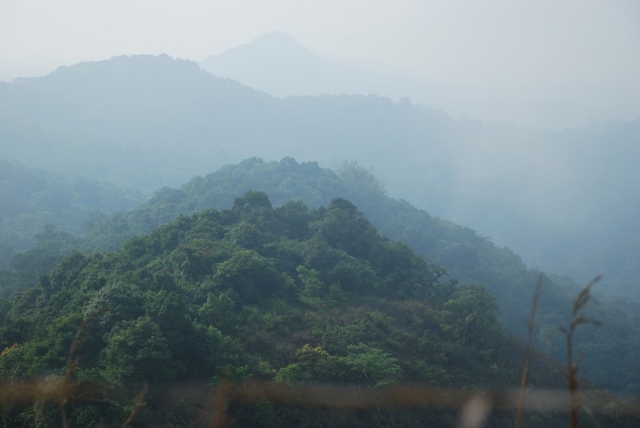
A mountain in Coorg (photo by Chandrachoodan Gopalakrishnan, Flickr Creative Commons, April 13, 2009)
AM: Your novel is set in the past and it’s full of historical and day-to-day detail of people’s lives. What kind of research did you do?
SM: To begin with I would say that 80 to 90 per cent of it is absolutely factual, but 10 or 15 per cent required imagination to knit together the pieces. I spent a lot of hours at the public library in New York, just reading. Literacy came very late to Coorg so there was a strong tradition of passing on a history through folk songs and things like that, but there was not very much by way of written record. Where I found stuff about Coorg was in the diaries and memoirs of European settlers and planters who had lived in the South. The other source was these really old, dusty government manuals where they talk about, “In 1899 the amount of rainfall was so much, and this amount of coffee was produced, and this amount of paddy was produced.” And in those dry facts I would try and recreate a monsoon season.
The other thing is that the physical landscape in Coorg hasn’t altered very much. So the club that I describe in the book is the very same club that my parents go to now and play bridge in the evening. It’s easy to walk around these old bungalows or the club and picture how they might have looked 100 or 150 years ago. Then, I’d visit Coorg once a year and I’d just sit and talk with older people and ask them about any memories they’d have of their childhood. The family joke was that I wanted to go talk with anyone over the age of 90. By the end of it all I had a really thick file on just background research.
AM: Where did the idea for those characters come from?
SM: I think that with the arts, whatever you create is a product of everything that you assimilate. While the characters, in and of themselves are not drawn on anybody in particular, they are in aggregate, a composite of people I have known. I find myself, my family and the people I’ve known in the characters. Devi is a willful, very headstrong character, and her strength is definitely modeled on a lot of the women I grew up with. The view that many people have about Indian women, especially in a historical context, is of women without a voice, without a lot of rights, and without a lot of strength. But things historically in Coorg have been different. Women have always stood shoulder to shoulder beside their men.
My great-grandmother, who I never met – there are stories of her that still percolate through the family – was widowed very young. My grandfather was the youngest, and he was barely a year old, and he had five other siblings. And this lady, who was not even five foot tall – she was tiny, but with a backbone of sheer steel. She made sure all of her children were educated, she singlehandedly managed home, finances, the property, and was a force to reckon with. I had her in mind as I was developing the character of Devi.

Family photo of Mandanna’s maternal great-grandparents, who are pictured at the far left (photo courtesy of Sarita Mandanna)
AM: One of the themes in the novel is unrequited love and thwarted love. Is the theme there for its dramatic potential or is it something that’s close to your heart?
SM: The story charted its own way, but it always surprises me when people talk about Tiger Hills as a love story because it was, in my mind, an exploration of what happens when things don’t go your way. Also, it isn’t just romantic love that’s explored, but the many different themes of love and all these different emotions that we club under the one umbrella of love – jealousy, possessiveness, obsession, all masquerading under the guise of love. True, unconditional love is rare. The story is an exploration of the ways in which we try and exert control over the ones we say we love the most, an exploration of what true love really might be, and what happens in the absence of love, in the aftermath of its loss.
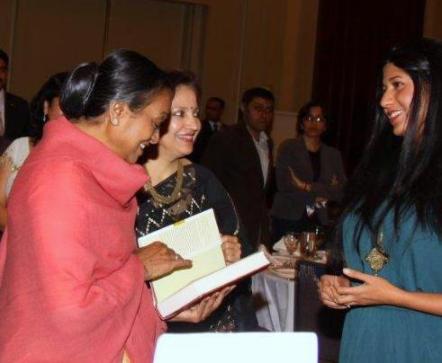
Mandanna in November 2012 with Meira Kumar (far left), India’s first woman Speaker of the House, and Preeti Saran, Consul General of India in Toronto (photo courtesy of Sarita Mandanna)
AM: It’s very difficult to get a novel published. How did you go about that?
SM: I was incredibly lucky. I finished the whole novel and then sent it off to a couple of agents, and one of the first people that I sent it to was David Godwin, out of London. He’s got a huge stable of authors, and a number of Indian authors – a number of Booker Prize winners, etc. – who are his clients. He called me at work and literally did not even get to finish his sentence. He said, “Sarita, it’s David, and I was wondering if you’d like to . . . ” and I said, “Yes!” I literally burst out of my chair, I was so thrilled – I was doing cartwheels all that day.
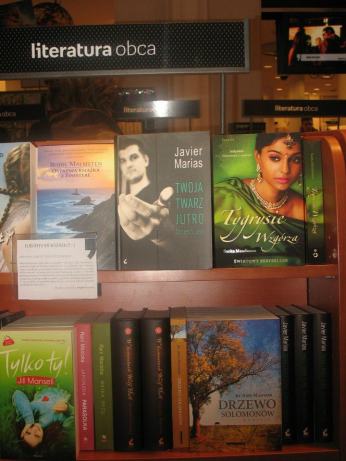
The Polish edition of “Tiger Hills” in a bookstore in Poland in 2011 (photo courtesy of Sarita Mandanna)
When you’re trying to get a novel published, it is invaluable to have a credible agent behind you. There are so many manuscripts, that when you have somebody of repute championing a manuscript, publishers give it that much more attention. David has been responsible for selling the book in as many markets as it has.
AM: I read online that you received a very large advance for the book.
SM: It is absolutely untrue. The Indian press went overboard. They started off by saying it was a million-dollar advance, which is ludicrous. Then they dropped it down to about $100,000, which is still absurdly high. If I had gotten even half of what they said I had, I would be a very happy woman. The large numbers don’t exist. Well, they do exist, but I think you either have to be very fortunate, very good or very known.
AM: Tiger Hills has been translated into 14 languages. How has the reception been in different countries?
SM: It’s hard to gauge this in detail, but in some markets it’s been remarkable. Poland, for instance, they just “got” the book and they “got” the story. There were reviews upon reviews that were amazing. In Israel, some of the reviews were incredibly touching and really lovely. Spain again, very positive, and they seem to have really gotten the book as well.
AM: Did you continue working at your job after the book was published?
SM: Yes, I did. And soon after that I left New York to come to Toronto because my husband was here. We were doing a bit of a long-distance marriage, so I came here and then was working here for a bit as well, and I’m on a sabbatical now to work on novel number two.
AM: Tell me about the novel you’re working on now.
SM: Not to sound evasive, but it’s still kind of early. If you’d asked me when I was writing Tiger Hills what the story was about, I would have come across as this kind of stammering idiot because I find it difficult to talk about a work in progress. The new novel is a different setting than Coorg. It’s a different theme altogether. I rattled around for a bit when I started writing the novel wondering what I wanted to do next, and this was a theme that I found myself more and more drawn to. It’s still in the early drafting stages where I’m working through ideas, fleshing out characters and stuff, so we’ll see how it develops.
AM: Do you feel a lot of pressure because of the success of your first novel?
SM: It’s very easy to lose your internal balance if you start thinking about how your work might be received or perceived. Yes, there are some days when you definitely wonder if what you’ve written is any good, but I try and shut it all out. I keep telling myself that I want to write this book the way I wrote Tiger Hills. When I started Tiger Hills I knew it was a completely unfashionable novel to write. I was writing something historical and so set in a strongly Indian context. But that was the story that I wanted to write. And I’m doing the same thing here. I don’t know how this is going to be received or if it’s even going to be published but I’m writing it because this is the story I want to tell.
For more information about Sarita Mandanna and her work, please visit saritamandanna.com.




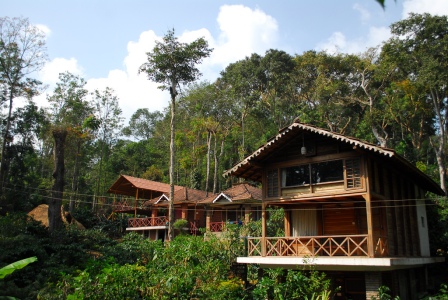

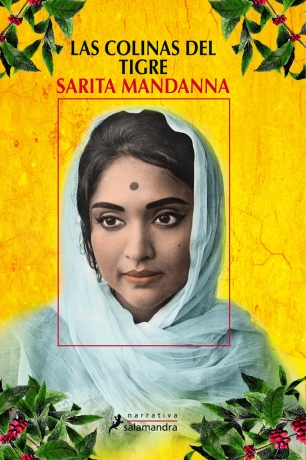


First of all i must say that i have read “tiger hills” and i enjoyed it very much. I have visited India few years ago and this incredible book reminded me a lot. I have read the intereview with Sarita Mandanna and i can say that it gave me a better understanding about the book. I understood that basicaly most of the story is based on true facts and characters and the rest came from the author’s immagination. Sarita mentioned a christian missioner by the name of Herman Gundert who died according to the story on 1927.I found in wikipedia that the same person died on 1896.which is true?
LikeLike